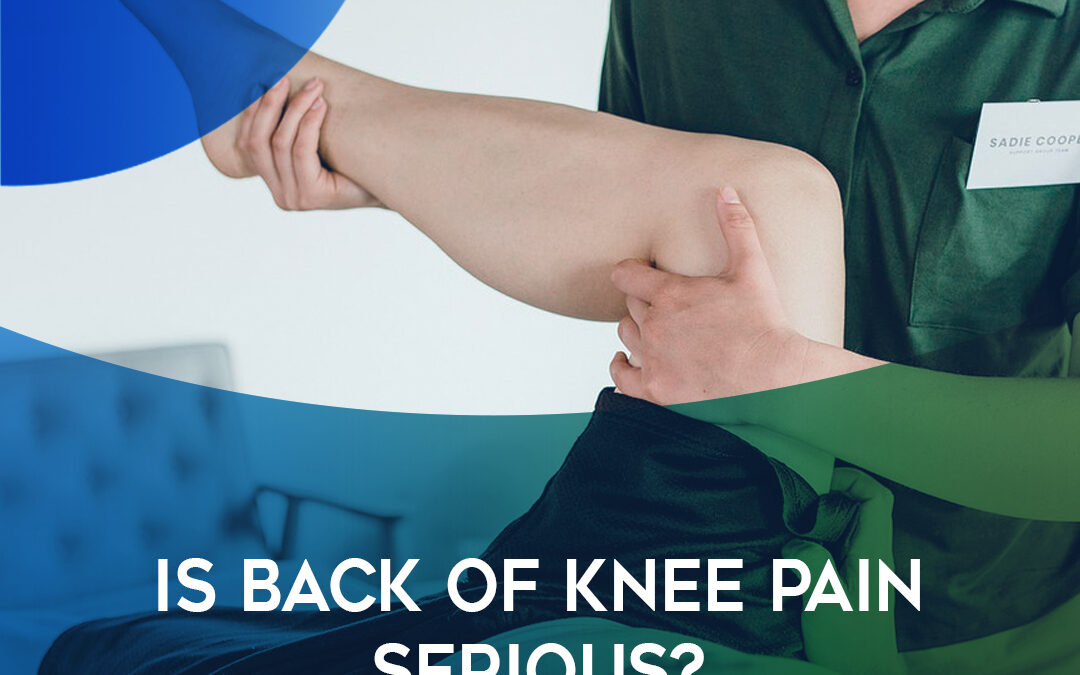Perhaps it came on as a sudden, sharp pain after exercising. Or perhaps it’s pain and discomfort that’s slowly worsened over several days or weeks. Or maybe it’s a persistent pain and stiffness in the mornings and after long periods of sitting. No matter what it feels like, one thing is clear…..you have back of knee pain.
And now it’s time for you to figure out how to handle it. When is knee pain serious and when can it be treated at home? Keep reading to learn when to practice at-home care versus when to call your doctor for back of knee pain.
Level 1: At-Home Care and Treatment
Many knee injuries occur from exercise, overuse, repetitive use and sudden activity. Common overuse or exercise-related injuries that cause back of knee pain include sprains, strains and cramps. In many cases, these types of acute injuries can be managed and resolved with at-home care measures.
If you develop an acute knee injury with pain, swelling, and discomfort during movement, your first course of action should be R.I.C.E.:
- Rest. Rest the injured knee and avoid activities that worsen the pain. Rest for at least a full week after sustaining an injury.
- Ice. Ice the injured knee to reduce inflammation, pain and swelling. Apply ice packs several times a day for 20 minutes at a time.
- Compression. Wrap the injured knee in an elastic bandage to reduce swelling.
- Elevation. Elevate the injured knee above the heart to reduce swelling.
While you’re waiting for an acute injury to heal, you can also take over-the-counter pain relievers to ease inflammation, pain and swelling. The most important part of the recovery process is allowing adequate time for the injury to heal. Even minor sprains and strains may take 2-4 weeks to resolve completely. Rushing back into your normal activities before your knee is healthy again increases the risk of developing chronic pain and knee arthritis down the road.
So how do you decide when it’s time to see a doctor, instead of using R.I.C.E. at home? We explore that in our next section.
Level 2: Medical Management
Injuries like ligament tears and cartilage tears usually require medical care and management. Sprains and strains that don’t resolve after a few weeks also warrant a trip to your doctor. Finally, if your back of knee pain is caused by an underlying condition like arthritis, you’ll need to see a doctor for treatment. The following signs indicate that it’s time to schedule a visit with your provider:
- Significant pain that interferes with daily activities and sleep
- Significant swelling
- Joint pain, tenderness, warmth and swelling
- A loss of mobility or range of motion
- Joint instability
- Limping
Your doctor will diagnose your knee pain and create a specific treatment plan based on your injury. Common medical treatments include medications, immobilization or splinting, steroid injections, and physical therapy. If you have a severely torn ligament, you may need surgery to repair the damage.
If your knee pain is caused by an underlying condition like arthritis, your doctor will create a long-term treatment plan to help you manage pain and symptoms. Your treatment plan might include medications, steroid injections, stretching and exercise, physical therapy, assistive devices, and weight management. If you have severe joint pain and damage, your doctor might recommend a total joint replacement.
Level 3: Emergent Medical Care
Injuries like complete tears, dislocations, fractures, infections and blood clots behind the knee may require emergency medical care and treatment. Seek immediate attention if you experience the following:
- Sudden, intense pain
- A popping sound during the time of injury
- Visible joint deformity
- An inability to move the knee
- An inability to bear weight on the knee
- An inability to walk without severe pain
- Numbness or tingling
- Red streaks spreading from the injured area
When Do I Contact iO-Core for Knee Pain?
If you have knee arthritis, traditional treatments like medications, injections, and physical therapy can reduce pain and symptoms but can’t slow or stop the progression of the disease. If you’re living with chronic pain, discomfort and loss of mobility, and you’ve been told that joint replacement surgery is the only treatment option left for you, contact us first.
Our team can help you determine if the iO-Core™ procedure is a viable treatment option for you. iO-Core™ is a minimally invasive procedure that combines orthopedics and biologics to treat degenerating cartilage and underlying bone and tissue damage caused by arthritis and joint injuries.
Treating the underlying damage and not just the surface layer of cartilage has shown better results over “standard of care” methods in decreasing pain and improving mobility for many patients. Many people who were told they needed a total joint replacement surgery have found long-term pain relief from iO-Core™ instead.
Call our team today to see if you qualify for the iO-Core™ procedure.

